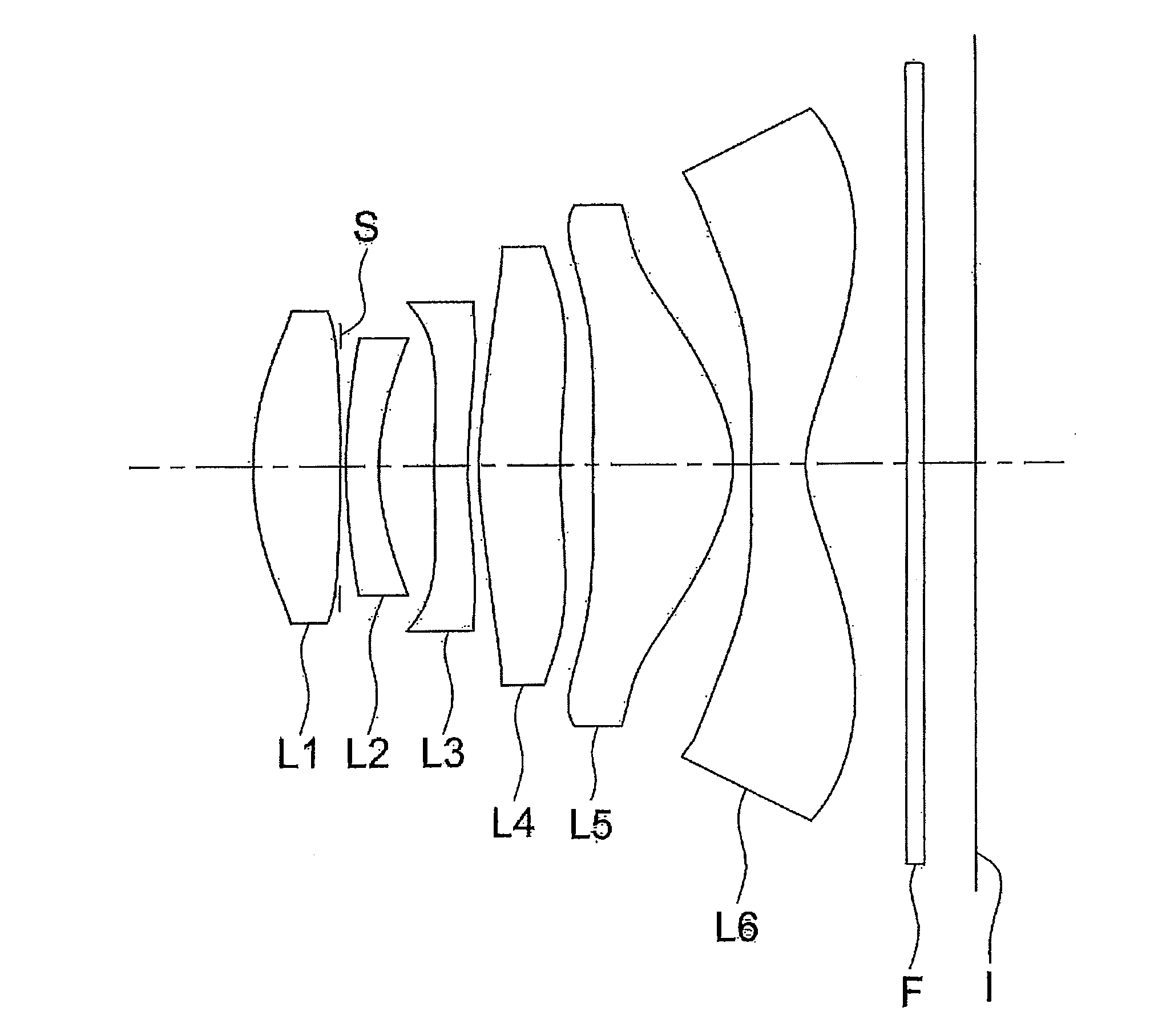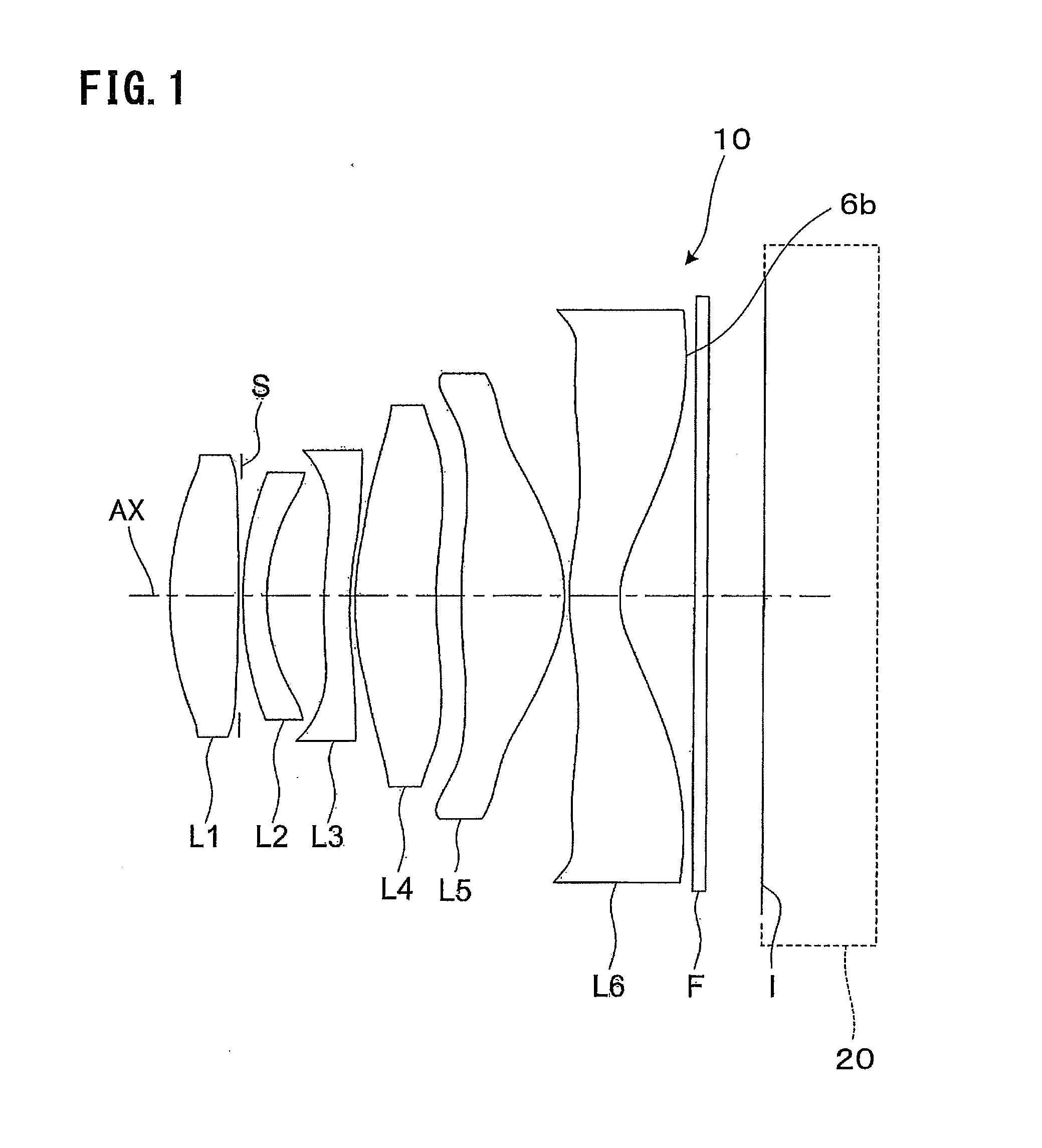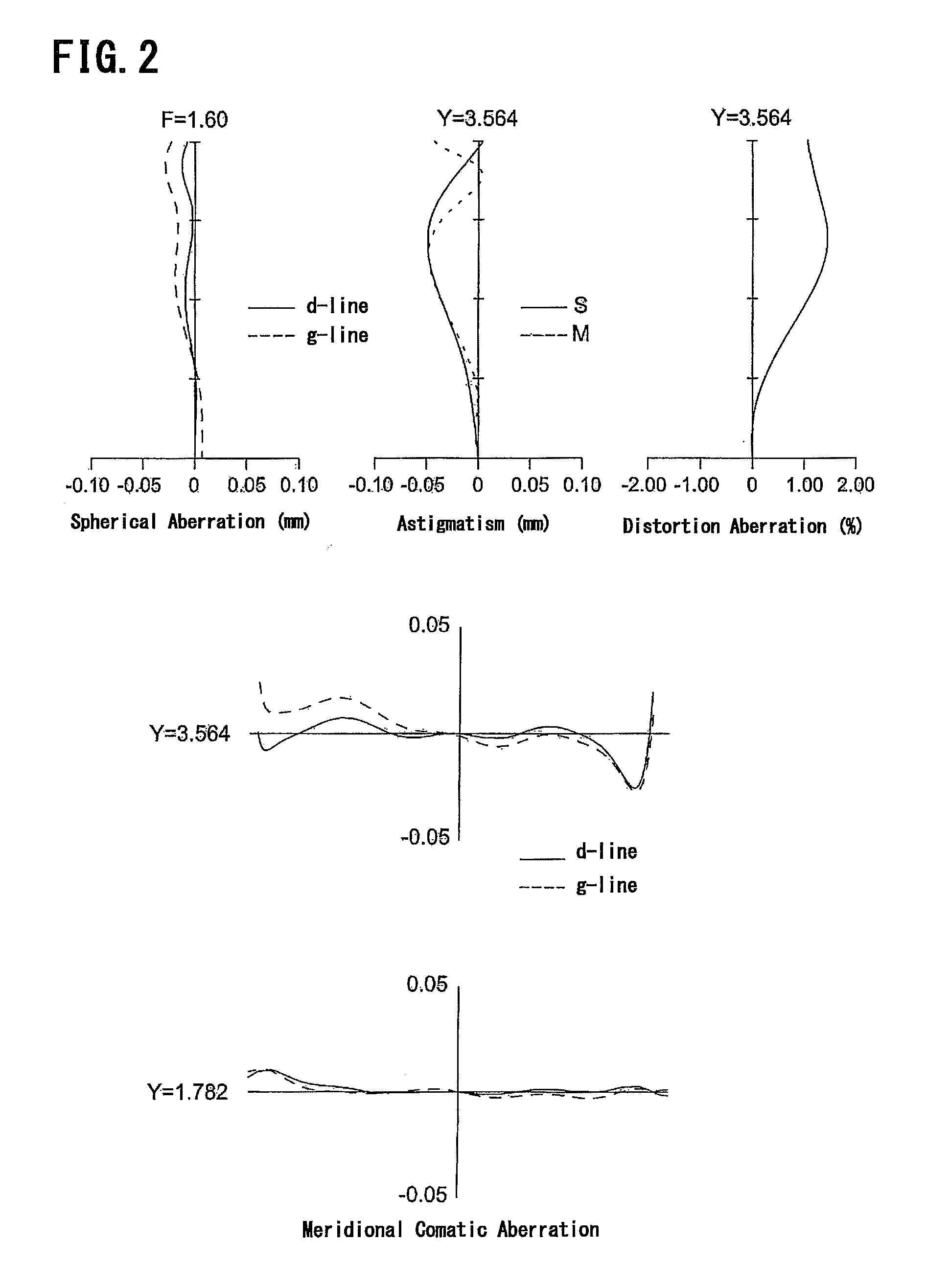Image Capture Lens
a technology of image capture and image, which is applied in the field of small and fast image pickup lenses, can solve the problems of insufficient high performance that cannot be realized by a conventionally used f-number, and achieve the effects of small size, favorable correction, and reduced total length of image pickup lenses
- Summary
- Abstract
- Description
- Claims
- Application Information
AI Technical Summary
Benefits of technology
Problems solved by technology
Method used
Image
Examples
example 1
[0098]General specifications of an image pickup lens are as follows.
f = 4.67 mmfB = 0.66 mmF = 1.62Y = 7.128 mmENTP = 0.57 mmEXTP = −4.07 mmH1 = 0.62 mmH2 = −4.01 mmSurface data of the image pickup lens is as follows.SER (mm)(Surface No.)R (mm)D (mm)Ndνd(Effective radius) 1infinite0.001.90 2*3.7030.811.5447056.21.67 3*−29.6980.001.50 4 (stop)infinite0.051.39 5*2.1570.301.6320023.41.45 6*1.6100.671.46 7*10.9260.301.6320023.41.50 8*2.9900.061.72 9*2.5510.941.5447056.22.1210*5.7640.322.2711*20.8131.221.5447056.22.4012*−1.1790.052.6413*4.3170.611.5447056.23.0514*0.9450.903.4115infinite0.151.5163064.13.4916infinite3.52Note that all the lenses are formed of plastic material.Aspherical surface coefficients are as follows.Second surfaceK = 0.15565E−02, A4 = 0.29538E−02, A6 = −0.29632E−02,A8 = −0.46862E−03, A10 = 0.55858E−03, A12 = −0.19525E−03Third surfaceK = −0.50000E+02, A4 = −0.97019E−02, A6 = 0.13535E−01,A8 = −0.10035E−01, A10 = 0.27070E−02, A12 = −0.33166E−03Fifth surfaceK = −0.63639E+...
example 2
[0100]General specifications of an image pickup lens are as follows.
f = 4.67 mmfB = 0.41 mmF = 2.02Y = 7.128 mmENTP = 0.58 mmEXTP = −3.47 mmH1 = −0.38 mmH2 = −4.26 mmSurface data of the image pickup lens is as follows.SR (mm)D (mm)NdνdER (mm) 1infinite0.001.71 2*2.6140.801.5447056.21.43 3*−20.7830.001.22 4 (stop)infinite0.051.08 5*3.8520.301.5830030.01.12 6*2.0080.511.18 7*12.8190.301.6320023.41.25 8*3.7620.101.48 9*2.8560.751.5447056.21.7910*4.9170.301.9911*26.9511.301.5447056.22.1312*−1.1220.162.3313*10.0200.501.5447056.22.6014*0.9710.903.2215infinite0.151.5163064.13.5316infinite3.56Note that all the lenses are formed of plastic material.Aspherical surface coefficients are as follows.Second surfaceK = −0.38280E+00, A4 = 0.95493E−03, A6 = −0.10642E−02,A8 = −0.33932E−02, A10 = 0.22394E−02, A12 = −0.96054E−03Third surfaceK = −0.50000E+02, A4 = −0.24570E−01, A6 = 0.46239E−01,A8 = −0.47052E−01, A10 = 0.20699E−01, A12 = −0.39872E−02Fifth surfaceK = −0.35321E+02, A4 = −0.17573E−01, A6 = ...
example 3
[0102]General specifications of an image pickup lens are as follows.
f = 4.67 mmfB = 0.5 mmF = 2.02Y = 7.128 mmENTP = 0.5 mmEXTP = −3.74 mmH1 = 0.03 mmH2 = −4.17 mmSurface data of the image pickup lens is as follows.SR (mm)D (mm)NdνdER (mm) 1infinite0.001.60 2*3.1110.711.5447056.21.38 3*1690.5580.001.15 4 (stop)infinite0.121.11 5*2.9380.301.6320023.41.19 6*1.9950.551.26 7*9.1990.301.6320023.41.34 8*2.7790.051.57 9*2.2770.831.5447056.21.8310*5.0610.342.0311*19.2731.291.5447056.22.2312*−1.2050.232.3513*7.6500.501.5447056.22.6114*1.0290.903.2715infinite0.151.5163064.13.5116infinite3.54Note that all the lenses are formed of plastic material.Aspherical surface coefficients are as follows.Second surfaceK = −0.55270E+00, A4 = −0.39988E−04, A6 = −0.12388E−04,A8 = −0.34779E−02, A10 = 0.22907E−02, A12 = −0.92168E−03Third surfaceK = −0.50000E+02, A4 = −0.32660E−01, A6 = 0.47584E−01,A8 = −0.46232E−01, A10 = 0.20627E−01, A12 = −0.42392E−02Fifth surfaceK = −0.15669E+02, A4 = −0.19361E−01, A6 = 0.3...
PUM
 Login to View More
Login to View More Abstract
Description
Claims
Application Information
 Login to View More
Login to View More - R&D
- Intellectual Property
- Life Sciences
- Materials
- Tech Scout
- Unparalleled Data Quality
- Higher Quality Content
- 60% Fewer Hallucinations
Browse by: Latest US Patents, China's latest patents, Technical Efficacy Thesaurus, Application Domain, Technology Topic, Popular Technical Reports.
© 2025 PatSnap. All rights reserved.Legal|Privacy policy|Modern Slavery Act Transparency Statement|Sitemap|About US| Contact US: help@patsnap.com



